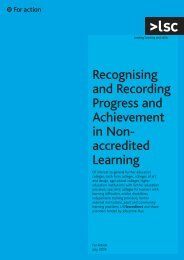Faiths and further education - Church of England
Faiths and further education - Church of England
Faiths and further education - Church of England
- No tags were found...
You also want an ePaper? Increase the reach of your titles
YUMPU automatically turns print PDFs into web optimized ePapers that Google loves.
37From working group to multi-faith team122The working group that originally worked together to set thechaplaincy up will normally be willing to work with the chaplaincyas it builds itself up into a team. It may be transformed into asupport group for the chaplaincy team. In a multi-faith chaplaincy,special care should be taken to build up the team into a smoothworking unit, in agreement about its goals <strong>and</strong> objectives, <strong>and</strong> howthey should be achieved.The overall goal – to serve the students<strong>and</strong> staff in a particular college – will have drawn those fromdifferent faiths <strong>and</strong> cultures together, but some may have had littleprevious experience <strong>of</strong> college or FE contexts, so team-building isessential.Action point:You may be just starting out or have been together for some time.• What stage has your team reached?Getting the team together123Before we arrive at the smooth working unit that functions almoston an unconscious acceptance <strong>of</strong> its values <strong>and</strong> goals, the workinggroup that gathers together for the first time in a small room in thecollege or in a corner <strong>of</strong> a noisy canteen must be seen as thebeginning <strong>of</strong> the chaplaincy activity.This group will develop its ownmethod <strong>of</strong> interaction, as does any group. Key factors are:• effective communication between all members• a collective identity <strong>and</strong> shared goals.124It could be expected that individuals who share the same overallvalues about tolerance <strong>and</strong> open-minded acceptance would quicklygel into an effective team.Well, let’s hope so. However, research hasshown that groups develop <strong>and</strong> mature as the individuals thatcomprise them get to know each other while working to achievethe shared goals.Tuckman’s (1965) model for group developmentidentified four stages.• Forming: This starts with the initial informal meetings in thecafeteria.At this stage, people are starting to get to know eachother on a personal <strong>and</strong> pr<strong>of</strong>essional level.• Storming: This is a usual stage, even for people engaged in aspiritual enterprise, where conflict <strong>and</strong> fallings-out can beexperienced as the negotiation <strong>of</strong> shared goals <strong>and</strong> objectives isentered into, perhaps where easy compromises are not available.• Norming: As the name suggests, at this stage, smoother water isreached as norms about ways <strong>of</strong> working <strong>and</strong> interacting aredeveloped.• Performing: At this point, perhaps it can be said that the grouphas turned into an effective, performing team.
















